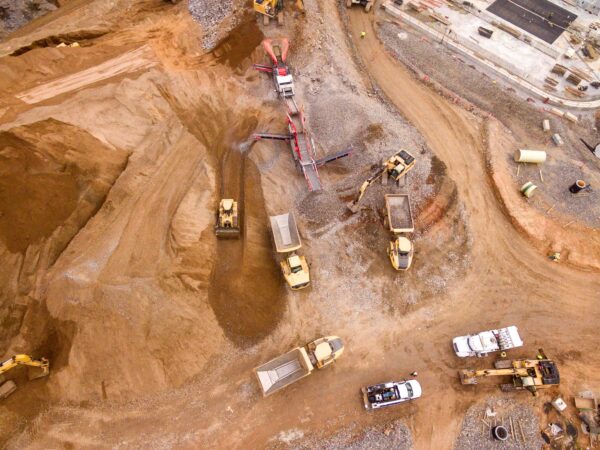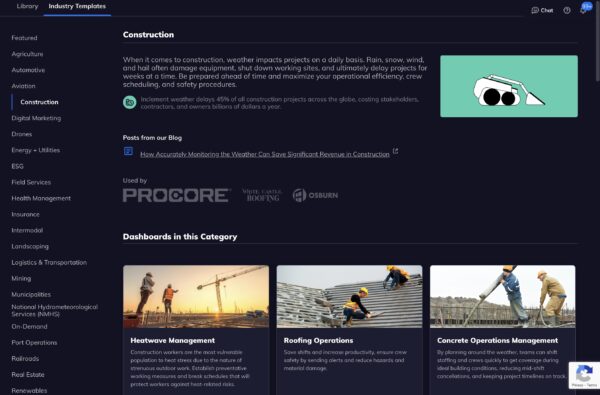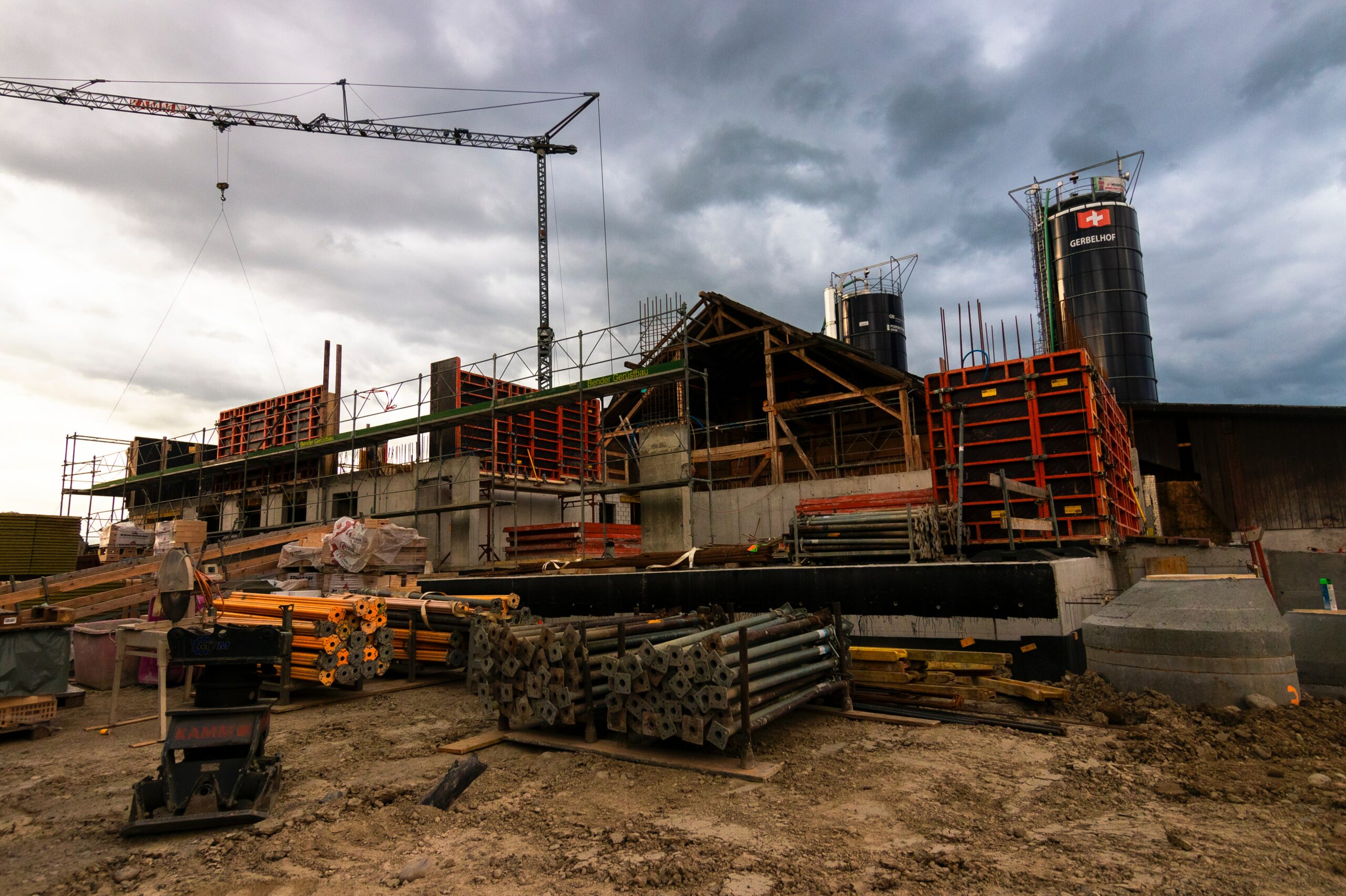Imagine you’re a construction manager juggling multiple projects and responsibilities while trying to anticipate the factors that could hamper your productivity. Out of all these uncertainties, one major unpredictable element constantly looms overhead. Literally.
What’s above? Everyday weather.
What if you had a tool available to combat the impact of severe weather conditions? Weather AI for construction stands poised to revolutionize the construction industry by allowing you more control over how weather impacts construction.
This blog will further break down this fascinating technology and explain how you can benefit.
What is Weather AI for Construction?

Weather AI for construction refers to using artificial intelligence to improve weather forecasting, prediction, output, and insight delivery for the construction industry. Weather AI represents a cutting-edge fusion between meteorology and artificial intelligence explicitly meant to help address high-impact and unique weather challenges before it happens.
Weather AI leverages historical weather data, algorithmic processing power, machine learning techniques, and real-time weather data to synthesize millions of data points into concise insights for business operations.
Such granular and precise weather intelligence allows stakeholders within the construction sector — from project managers to safety officers — to make more informed decisions. They can better plan weather days, adapt work schedules, manage risks associated with adverse conditions, and ease cost controls through increased predictability.
Artificial intelligence and weather are fast becoming integral aspects of modern-day construction project operations.
How Does Weather Impact Construction Projects?
One often under-looked factor that significantly impacts construction projects is the weather. This influence can be immediate, like sudden storms causing work stoppages, and prolonged, such as long bouts of rain-producing unfavorable ground conditions for building foundations.
“The most significant impact is really schedule delays. When weather delays a project schedule, it exposes us to increased costs, both from a general conditions perspective as well as for potential liquidated damages.
Delayed completion affects clients as well; they have financing on projects, they have delivery dates, they have opening dates that are planned for hotels and restaurants. So really, scheduled delays are the most importatnt aspect.
Weather also affects supply chain disruptions and overall material availability; the ability to get materials on-site and installed into the project are incredibly important,” Says Mike Kehoe, CFO PCL Construction.
Here’s a little more on the weather’s impact on construction projects.
Projects Delayed by Weather
Predictable or not, everyday weather can wreak havoc on any construction timetable. Adverse conditions might make it risky, if not entirely impossible, to carry out certain activities; laying concrete in the rain or doing roofing during strong winds are prime examples. Unpredictable severe weather events, from hurricanes to hailstorms, also result in impressive project delays.
Employee Safety at Risk
Aside from inducing delays, inclement weather poses significant safety risks for employees on-site. Rain-soaked equipment and lightning storms form an electrocution hazard. At the same time, slippery surfaces elevate the risk of falls – the leading cause of death in the industry, according to data from Occupational Safety and Health Administration (OSHA). High stakes underline the need for preemptive action against extreme weather phenomena within construction safety considerations.
Wind hazards are particularly dangerous when dealing with crane operations; gusts over 20 mph require work halts as governmental guidelines dictate, primarily due to stability concerns.
Increased Costs and Claims
Weather disruptions also bring on extra financial implications—delayed costs resulting from rearranged schedules hit hard, especially considering renting costly equipment like cranes that need paying even while stationary.
Adverse weather often leads to delayed projects, heightened safety risks in challenging outdoor environments, and escalating costs. The root cause of these issues? A lack of real-time and accurate prediction capabilities. This lack is precisely the problem that AI weather prediction technology for construction aims to address.
Lack of Accurate Weather Data
Obtaining accurate and precise weather intelligence for construction sites has sometimes been challenging. Conventional forecasts offer only a broad overview with limited geographical and temporal specificity, which doesn’t always align with construction needs.
Another challenge arises from calculating how specific weather conditions would impact different phases of a typical construction project timeline. Without this vital information, managing resources becomes a daunting task. Weather AI solutions aim to provide historical weather data up to 20 years back, informing construction project managers on how the weather has behaved in an area.
Deteriorating Conditions Lead to Material Wastage
Weather also has cruel ways of impacting materials used in the building process. A sudden downpour may render stockpiles of raw materials useless, leading to unnecessary waste and spending directly associated with replenishing these stocks. With AI for weather, construction companies can better prepare their site for high-impact weather and create contingency plans.
Tomorrow.io’s Weather AI for Construction

Tomorrow.io Construction Weather Insights Templates
Imagine arriving at a construction site one morning, and it’s a sunny clear day. You start working normally, and then without any warning, a powerful thunderstorm strikes down a few hours later. The storm completely stops your project, halting progress and sending everyone home.
We’re all very familiar with the construction industry being vulnerable to weather-related risks, but are you familiar with the existing solutions to combat this?
If you’re like most construction firms, you’re reacting to the daily changes in weather and relying on traditional weather forecasting methods, i.e., local weather reports, weather apps, and the NWS. But these methods do not paint a complete picture of what’s going on.
That’s where solutions like Tomorrow.io’s AI-backed weather intelligence platform for construction come in. Tomorrow.io utilizes sophisticated machine learning algorithms, AI, and upcoming next-generation weather data from their first two Pathfinder satellites. This tool has been designed to focus on accuracy and timeliness by providing hyperlocal near-real-time weather forecasts and AI-created weather insights to support your operations.
Tomorrow.io’s construction solution serves as a vital assistant in navigating numerous weather-related challenges by:
- Providing detailed, hyper-localized weather forecasts.
- Offering alerts about potentially hazardous conditions well ahead of time.
- Giving access to historical weather data for construction proves helpful during project planning.
With weather AI from Tomorrow.io, the construction industry can do much more, including enhancing the decision-making process, boosting productivity around weather, and helping keep employees safe.
Enhanced Decision Making
By leveraging historical weather data for construction and real-time forecasts, project managers become empowered with insights that can directly influence operational choices. Ultimately, this leads to better allocation of resources, from workforce utilization to material supply logistics.
Productivity Boost
Weather AI for construction is also an essential tool when striving to enhance productivity levels on site. Real-time weather monitoring enables adept scheduling of tasks according to everyday weather patterns. For instance, somebody scheduling outdoor activities may plan them during favorable weather windows, whereas indoor tasks might be allocated for times predicting heavy showers or extreme winds.
Injury Prevention
Lastly, Weather AI is crucial in promoting safety measures within construction sites. Robust technologies can predict wind hazard updates for crane operations or offer valuable input regarding best timeframes for concrete pouring optimization—contributing to overall productivity and, more importantly, risk reduction and injury prevention.
In short, integrating advanced solutions like Weather AI opens up myriad possibilities within intelligent construction project delivery.
How Weather AI Can Help With Construction Projects
Adopting weather AI for construction projects is no longer a nice-to-have but an absolute necessity for timely completion and resource optimization. From the preliminary planning phase to everyday weather monitoring, AI has the ability to make a difference in construction. We’ll discuss possible use cases below.
Accurate Forecasting
First on the list is the precision brought about by AI in forecasting everyday weather. Weather AI offers accurate estimations, which, in turn, saves valuable time during project planning and execution. With better weather data, contractors are able to plan weather days in advance, be aware of daily changing weather, and allocate resources accordingly.
Pre-Project Planning
Comprehensive pre-project planning sets a solid foundation and dictates the success of a project. Using historical weather data for construction during this stage provides valuable insights and aids in choosing the best time frames for operation. Here are two ways it makes a difference:
Understanding Typical Weather Patterns
Project planners can now predict local weather conditions much more accurately with historical data access and AI-powered forecasting for specific plans. AI can help create flexible yet efficient timelines by helping you factor in potential delays due to average seasonal changes and avoidable calamities.
Resource Allocation
By gaining clarity on how normal conditions and adverse weather events have previously impacted work progress, supervisors could allocate human resources and machinery better, reducing idle times significantly.
Daily Weather Monitoring
Everyday weather unpredictabilities present a significant challenge hindering optimal performance at construction sites. Consequently, incorporating AI into daily weather forecasting becomes indispensable.
Real-Time Updates
Advanced weather intelligence systems powered by AI have the ability to provide automatic alerts regarding impending extreme situations like storms or hurricanes, enabling timely preventive measures.
Efficient Workflow Management
Knowledge about trivial interruptions such as unscheduled rains can aid supervisors in grouping tasks efficiently and manipulating work schedules effortlessly, keeping productivity high.
Concrete Pouring Optimization
Concrete pouring is a seasonally dictated process where costs overrun if not done correctly. Here’s where artificial intelligence construction keeps costs low while ensuring superior quality:
Weather Aware Execution
With improved weather awareness, picking opportune times during the day to perform specific construction tasks means having favorable conditions aiding fast concrete pour curing.
Ensuring Strength & Durability
Pouring under prescribed temperature levels and humidity preserves integral properties, thereby enhancing life span decreases the need for future repairs impacting long-term project economy positively.
Wind Hazard Updates for Crane Operations
Cranes used in construction are highly sensitive to on-site wind speeds. Inaccurate velocity readings can increase the risk of accidents, which can halt operations and result in unexpected insurance claims. It’s essential to mitigate these risks using AI-based weather intelligence tools such as Tomorrow.io.
Wind Data for Crane Operations
These tools facilitate proper crane activity scheduling, ensuring lifts are only done during permissible wind speed periods, increasing operational safety standards significantly. Tomorrow.io offers various data layers, including low-level winds and temperature data, which provide crucial insights on wind speed, wind direction, and temperature at various altitudes – from 10 to 300 meters above. Construction sites can significantly benefit from this data and be more informed on the right time for crane operations.
Risk Mitigation
Artificial intelligence for construction has the ability to possibly manage potential risks that occur due to harsh weather. This proactive approach aids companies by reducing unnecessary expenditures caused by unforeseen hazards and equipping their crews with the tools they need to make better decisions around weather events.
Enhancing Employee Safety
Employee safety is every construction site manager’s #1 concern. The construction industry has drastically improved safety by integrating artificial intelligence into decision-making processes. Leveraging these systems allows you to foresee possible threats posed by inclement weather. As a result, harmful incidents can be anticipated and, most importantly, prevented by removing employees from unsafe situations and turning off equipment when needed.
Conclusion: The Impact of Weather AI On Construction
The game-changer the construction industry has been waiting for is here with Weather AI. This ingenious technology redefines efficiency and takes safety to new heights. With precise real-time weather forecasts, weather AI for construction helps control costs, slashing weather-related delays and cutting down the risk of cost overruns. Historical weather data gives you an edge in strategic planning and boosting productivity while ensuring safety remains a top priority.
With timely alerts for potential hazards, you’ll say goodbye to crane operation mishaps during high winds and significantly reduce work-related accidents. Plus, with Weather AI, construction crews can optimize work schedules around high-impact weather events, ensuring productivity and protecting your valuable materials and machinery. It’s time to embrace AI in construction and watch as it paves the way to a safer, more efficient workplace and a promising future brimming with growth.
Interested in learning more about how AI is changing the construction industry?
















